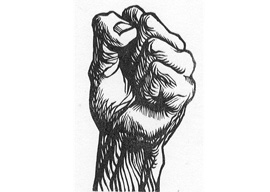
December 14, 2011

This last idea—of ever-sinking conditions—is hard to reconcile with the last two hundred years’ massive increases in overall living standards. Marx himself had a hard time fitting this idea into the world in which he lived. He conceded a rise in Britain’s agricultural workers’ pay from 1845-1849 but called it “practically insignificant.” When pressed on the numbers in public, Marx admitted it was “about forty percent.”
In the market economy, there is a natural price for everything. Prices are determined by the supply of, and the demand for, a given good or service. This is also true for labor.
If the natural price for labor is $5 per hour for an unskilled worker, and unions seek to collectively bargain for wages higher than $5 per hour, why would a business ever hire a union worker? Why would a struggling business not fire all of their union workers who demand relatively higher wages and hire non-union workers demanding relatively lower wages?
The answer is simple: The government does not make it that easy.
To understand this fact, one must become familiar with both the Norris-La Guardia Act of 1932 and the Wagner Act of 1935.
The former made condition of employment contracts—not to join unions—non-enforceable in court, it made unions exempt from antitrust laws, and it removed federal courts’ jurisdiction in labor disputes. The latter is credited with forming the National Labor Relations Board which oversees and enforces a number of labor laws. On their website they list examples of illegal employer activities:
Threatening employees with loss of jobs or benefits if they join or vote for a union or engage in protected concerted activity.
Threatening to close the plant if employees select a union to represent them.
Questioning employees about their union sympathies or activities in circumstances that tend to interfere with, restrain or coerce employees in the exercise of their rights under the Act.
Promising benefits to employees to discourage their union support.
Transferring, laying off, terminating, assigning employees more difficult work tasks, or otherwise punishing employees because they engaged in union or protected concerted activity.
Transferring, laying off, terminating, assigning employees more difficult work tasks, or otherwise punishing employees because they filed unfair labor practice charges or participated in an investigation conducted by NLRB.
Both the Davis-Bacon Act of 1931 and the Walsh-Healey Act of 1936 prescribe federal regulation of minimum wages. Davis-Bacon requires “prevailing wages” on all government construction contracts over two thousand dollars. Walsh-Healey extends the requirement of “prevailing wages” to all government contracts over ten thousand dollars. And finally, the Fair Labor Standards Act of 1938 extended federally mandated minimum wages to the entire country.
Unfortunately, minimum wages have consequences. Any economist will tell you that price ceilings cause shortages and price floors cause surpluses. Since a minimum wage is a price floor (i.e., by law, prices are not allowed to fall below a certain level), the effect is a surplus of labor—also called unemployment. Because of this, minimum-wage laws eliminate competition.
Say the natural price for labor is $5 per hour for an unskilled worker, meaning a sufficient number of workers are more than willing to do the job for $5 per hour. If government fiat imposes a minimum wage of $7 per hour, relatively lower-paid workers are eliminated from freely competing with relatively higher-paid workers. Such artificially imposed higher wage levels protect union jobs from those willing to compete on price.
The strike, or the threat of a strike, is the unions’ main weapon to bend management to their will. But it’s more than a strike, as economist Morgan Reynolds notes in his book Power and Privilege: Labor Unions in America:
A union’s problem is painfully obvious: organized strikers must shut down the enterprise, close the market to everyone else—uncooperative workers, union members, disenchanted former strikers, and employers—in order to force wages and working conditions above free-market rates. If too many individuals defy the strikers…then unionists often resort to force. Unionists ultimately cannot impose noncompetitive wage rates…unless they can prevent employers from hiring consenting adults on terms that are mutually satisfactory. Unions must actively interfere with freedom of trade in labor markets in order to deliver on their promises.
Unions demand higher wages for themselves at the expense of others. And they do so by government coercion.
As economist Robert Barro notes, when employers band together for the highest price possible it is outlawed as a form of reprehensible greed, while when employees band together seeking the highest price possible it is considered heroic and just.
Read all you can about unions. Contradictions abound.
And Trumka is nothing but a political hack.